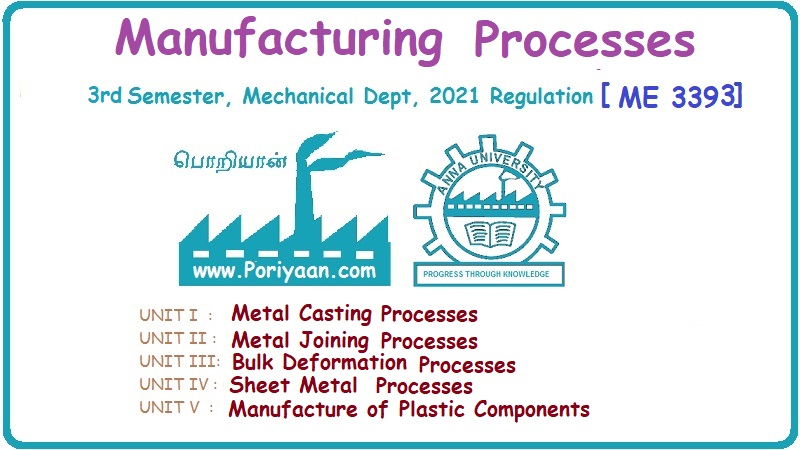Manufacturing Processes: Unit IV: Sheet Metal Processes
Shearing Dies
type with Advantages, Disadvantages | Sheet Metal Processes
Die is a tool used to cut or shape the material in a press. Dies are custom designed on the basis of parts to be produced.
SHEARING DIES Die is a tool used to cut or shape the material in a press. Dies are custom designed on the basis of parts to be produced. A die set is the fundamental portion of every die. Figure 4.13 shows the components of a die. It consists of two halves such as upper shoe and lower shoe. The die block is attached on the lower shoe. The die opening (female part of the die set) is machined on the die block. The punch plate is attached on the upper shoe. The punch (male part of the die set) is fastened on the punch plate. Both die block and punch plate are separate from die shoes by backup plates. Both die shoes are connected by guide pins or guide posts which provide a precise alignment of these two halves during die operation. The dies may be classified according to the type of operation performed and according to the type of construction of die. The various types of dies are as follows. Simple dies are designed to perform any single specific operation such as blanking, punching, notching, trimming, etc. It consists of standard components of a die set. It may also be called a single operation die. Stop pins are also provided in the die for indexing the strip of sheet metal. Progressive die is also known as cut-carry die. It is a multi-station die that performs several operations in a single stroke of the ram in a press. The stock strip is advanced through a series of stations that perform one or more distinct die operations on the workpiece. The strip must move through each succeeding station to produce a complete workpiece. After that, a complete workpiece is produced with each stroke of the ram. Example, piercing operation is carried out in one station and it is further progressed to the next station to perform blanking operation. At the same time, the next piercing operation will be performed for the second washer while blanking the first washer. Figure 4.13 shows a progressive die to carryout both piercing and blanking operations. The stock strip is fed into the die mechanically or by hand. The primary stop is pushed-in by hand to hold against the lead end of the sheet metal. The primary die stop is drawn back after the hole is pierced. The hole is pierced by the piercing die set in the first cutting stroke of the ram. After the primary die stop is released, the stock advances to the next station where it contacts the automatic button die stop. The correct spacing is obtained by the help of a secondary stop pin. In the second cutting stroke of the ram, the pilot of the blanking punch enters the pierced hole and it ensures exact alignment of the stock as the part is blanked. At the same time, the blanking punch descends and shears the metal to form a washer. While the blanking operation is performed, the piercing punch produces a hole for the next washer at the first station. Thus, after the first stroke, when only a hole is punched, each stroke of the press produces a finished washer. The blanking and piercing punches should not be of same height. A stepping is given in order to reduce forces. For piercing operations, the punch will have the shear and the die will be flat. For blanking operations, the punch will be flat and the shear is given to the die. Advantages: (i) The number of operations can be performed with one handling of the stock strip. (ii) For every stroke of the ram, one workpiece is made. (iii) It is fairly simple to construct and it is more economical to repair. (iv) It is suitable for mass production. Disadvantages: (i) Thin stock of soft materials may cause troubles by bending or tearing around piloting holes. (ii) Workpiece may become dished as they are pushed through the die since they have less support. (iii) It is complicated design of die set as compared with simple dies. (iv) The cost of die set is high when compared to simple die set. In a compound die, two or more cutting operations such as blanking and piercing operations are combined and carried out in one stroke of the press at one station only. In order to perform this operation, both upper and lower elements of the die set carry punching and blanking elements are placed directly opposed to each other. In other words, the piercing punch acts in the opposite direction with respect to the blanking punch. Figure 4.14 shows a simple compound die. It is used for producing a workpiece (i.e., washer) which is pierced and blanked at one station in one stroke. Here, the blanking punch also serves as the piercing die. The blanking punch and blanking die opening are mounted in an inverted position. The sidewalls adjacent to cutting edges of the blanking die opening are straight because the blank does not pass through the die. During part of the stroke, the hole is pierced on the stock and upon further travel, the blanking operation is done. Angular clearance must be provided on the piercing die to allow slugs to drop through the die. The main difference between progressive and compound dies is, 'N numbers of washers can be produced in 'N' strokes of ram in the case of compound dies but 'N+1' strokes are needed to produce 'N' washers for progressive dies. The progressive and compound dies are mainly used to perform cutting operations. Advantages: (i) More accurate workpiece can be produced. (ii) Large parts can be blanked in a small press if compound dies are used. (iii) Shorter length of strip materials can be used. (iv) The cost of production is less. Disadvantages: (i) It is more expensive to construct and repair. (ii) It is slower in operation as compared with progressive dies. (iii) The design of the die set is complicated when compared to progressive dies. (iv) The tonnage requirement is high. Comparison between progressive and compound dies: In combination dies, in addition to cutting operations, non-cutting operations are also performed. In other words, both cutting and non-cutting operations (forming) are combinedly carried out in one stroke of the press. The typical cutting operations that may be performed in the combination die are blanking, punching, trimming, cutting-off, etc., whereas non-cutting operations are bending, forming, extruding, embossing, etc. Figure 4.15 shows a combination die that blanks and draws a cup. The upper die block has a blanking punch at its centre. As the punch descends, the metal is first sheared and required size of the blank is obtained. The drawing punch is now actuated and drawn out the metal while the blanking punch serves as a pressure pad. A spring stripper strips the skeleton from the blanking punch. A knock out bar extending through the centre opening is used to eject the drawn out part at the end of stroke. Difference between combination die and compound die:1. Simple Dies
2. Progressive Dies
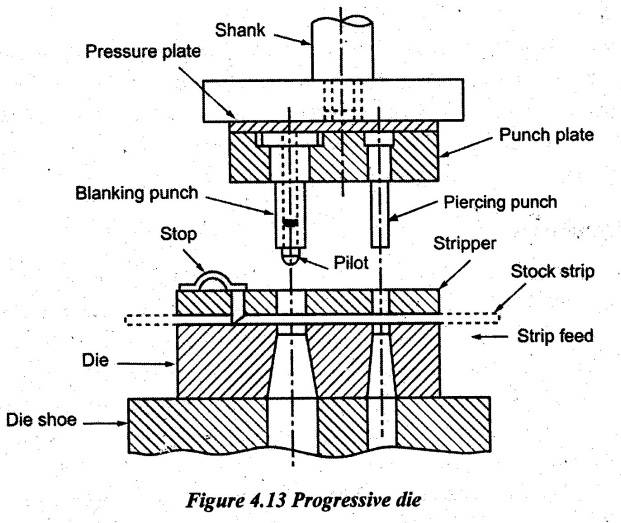
3. Compound Dies
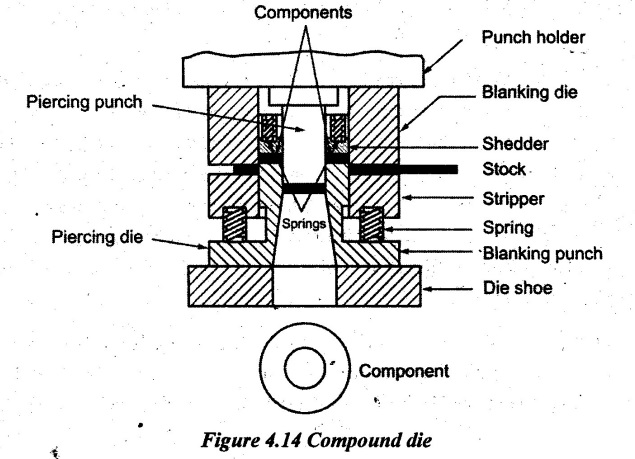
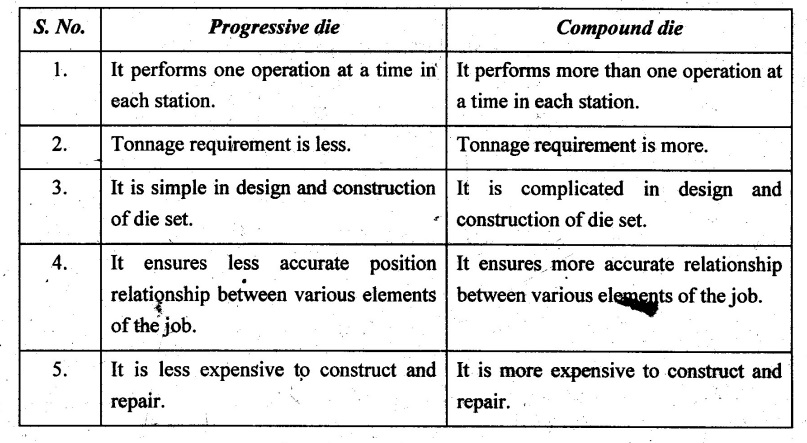
4. Combination Dies
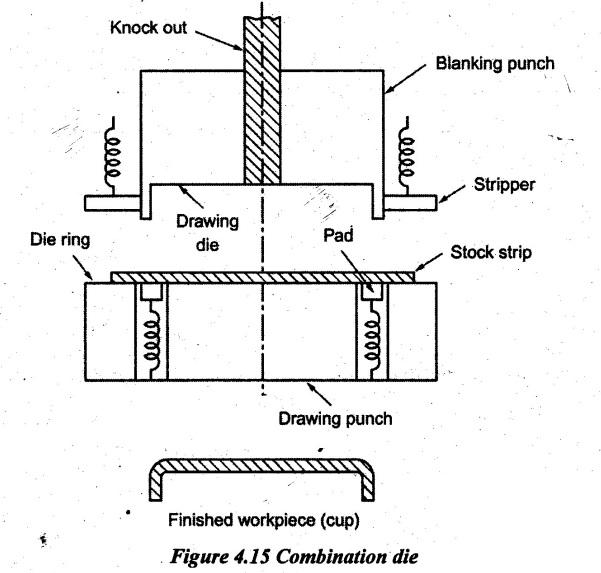
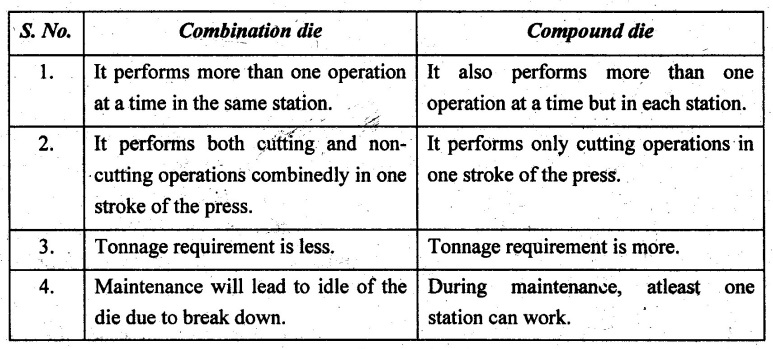
Manufacturing Processes: Unit IV: Sheet Metal Processes : Tag: : type with Advantages, Disadvantages | Sheet Metal Processes - Shearing Dies
Related Topics
Related Subjects
Manufacturing Processes
ME3393 3rd semester Mechanical Dept | 2021 Regulation | 3rd Semester Mechanical Dept 2021 Regulation
